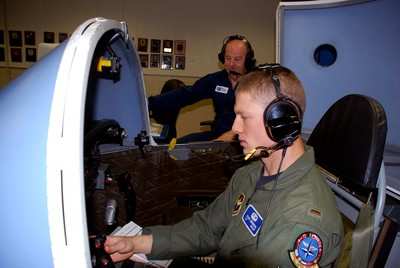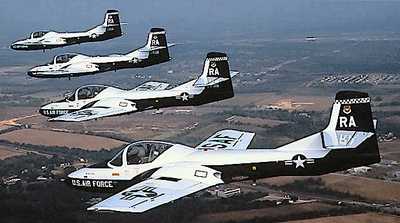 No one wants to be last in anything he or she does, especially
when it comes to the highly-competitive Euro-NATO Joint Jet Pilot
Training Program, the world's only multi-nationally run
undergraduate pilot training organization.
No one wants to be last in anything he or she does, especially
when it comes to the highly-competitive Euro-NATO Joint Jet Pilot
Training Program, the world's only multi-nationally run
undergraduate pilot training organization.
But 2nd Lt. Evan Negron, a 25-year-old Salem, N.J., native, said
April 23 he didn't mind being the last student in the program's
27-year history to train in the T-37 Tweet simulator at Sheppard
AFB.
"I really feel blessed and fortunate to be in the last T-37
class," he said. "I think it's neat to be part of a legacy."
After more than 50 years of service, the Tweet is scheduled for
retirement this summer, marking an end to one of the Air Force's
most durable and venerable airframes.
While being the last student to train in the simulator was an
honor in and of itself, the lieutenant said having the civilian
instructor who provided the instrument lesson with him was just as
much an honor. Wolfgang Ruhl, a former German pilot and instructor
with the Euro-NATO Joint Jet Pilot Training Program since 1977, was
the first instructor to train other pilots when the program was
born in 1981. He became the last to instruct in the Tweet simulator
for the heralded organization.
"He has a lot of experience (in this trainer)," Lieutenant
Negron said. "All the instructors are good."
Mr. Ruhl said the retirement of the Tweet, and thus its
instrument trainer, is somewhat bittersweet. He said he understands
why the decision was made to replace the Tweet with the modern and
more-efficient T-6A Texan II. Just like the actual aircraft, he
said there isn't a more reliable simulator in use.
"It's simpler and easier to maintain," he said. "It's excellent.
We've gotten excellent use out of it." The simulator itself is a
mockup of the aircraft's cockpit with identical instrument panels
and controls. Like the actual airframe, it has two seats: one for
the instructor and one for the student. It also has a canopy that
closes to aid in nighttime instrument training.

The biggest difference between the T-37 simulator and its
high-tech counterparts -- the T-6 and T-38 Talon simulators -- is
technology. Those simulators give students the ability to see their
surroundings just as they would from an actual aircraft.
Lieutenant Negron said he heard some good things about the Tweet
simulator prior to graduating from the Air Force Academy and
beginning training in November 2008.
"A lot of people told me about the aircraft in general, but for
instruments, the simulator is key," he said. "I heard that it's
good to 'fly' in the simulator first and make mistakes there. You
can't do that in the aircraft."

The lieutenant said the simulator helped him get used to where
controls, switches and instruments are located before he touched
the actual Tweet. It also allowed him to get comfortable with
different procedures and learn techniques that would enable an easy
transition to the aircraft. Mr. Ruhl's final thought on the
simulator was in-line with the aircraft that will soon retire.

"This is the most reliable, safest trainer," he said. "This
lasted for more than 50 years." The last class of T-37 pilots is
scheduled to advance to the T-38 Talon in late June or early July.
[ANN salutes John Ingle, 82nd Training Wing Public Affairs for the
story.]
 ANN's Daily Aero-Term (04.14.24): Maximum Authorized Altitude
ANN's Daily Aero-Term (04.14.24): Maximum Authorized Altitude ANN's Daily Aero-Linx (04.14.24)
ANN's Daily Aero-Linx (04.14.24) Classic Aero-TV: 'We're Surviving'-- Kyle Franklin Describes Airshow Life 2013
Classic Aero-TV: 'We're Surviving'-- Kyle Franklin Describes Airshow Life 2013 Aero-News: Quote of the Day (04.14.24)
Aero-News: Quote of the Day (04.14.24) Airborne 04.09.24: SnF24!, Piper-DeltaHawk!, Fisher Update, Junkers
Airborne 04.09.24: SnF24!, Piper-DeltaHawk!, Fisher Update, Junkers






